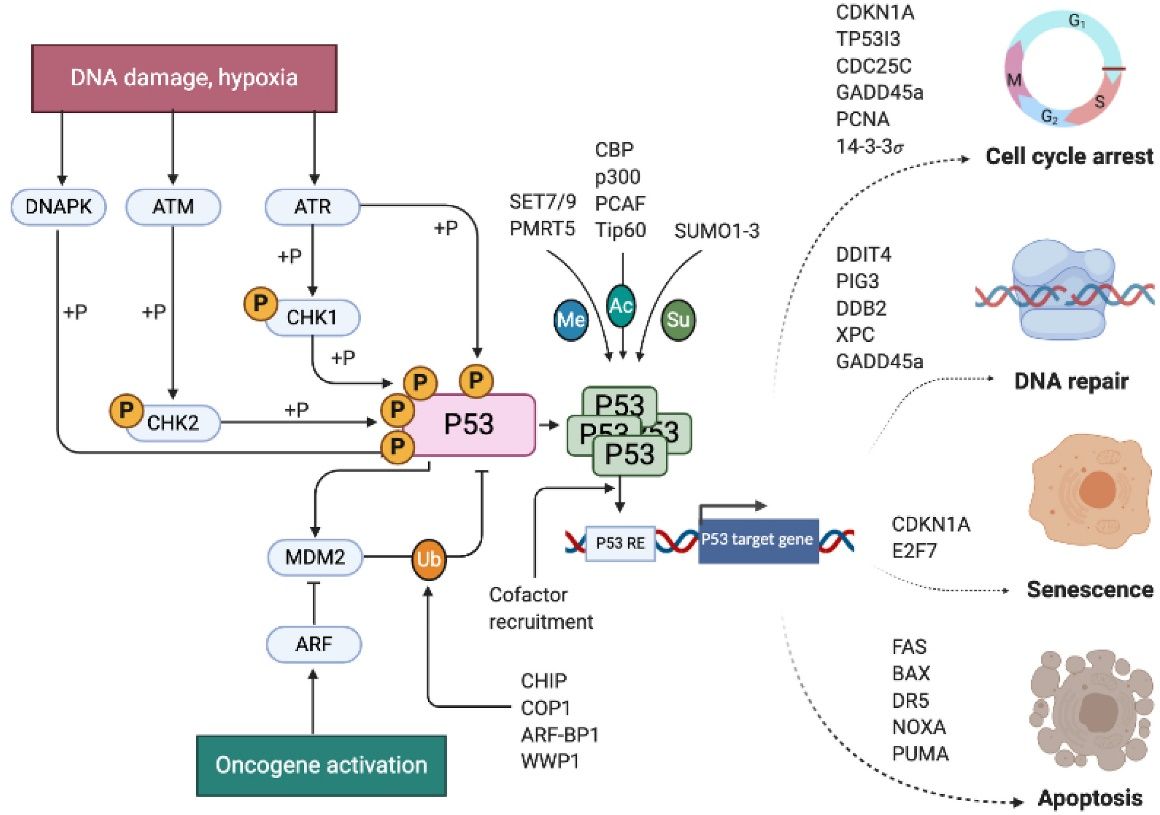What is TP53 Protein
The TP53 protein, also known as tumor protein p53, is a crucial player in cellular regulation, safeguarding the integrity of the genome. Its official full name is "transformation-related protein 53," and it goes by various synonyms such as p53, cellular tumor antigen p53, and antigen NY-CO-13. TP53 belongs to the p53 family of proteins, which also includes p63 and p73. Structurally, TP53 is a transcription factor with a modular organization, consisting of multiple domains like the N-terminal transactivation domain, DNA-binding domain, and the C-terminal regulatory domain. Recent research advances in understanding TP53's structural characteristics have shed light on its intricate functions in cellular processes.
TP53 Biological Functions and Molecular Mechanisms
The biological functions of TP53 are multifaceted, reflecting its role as a guardian of the genome. Primarily, TP53 acts as a transcription factor, orchestrating the expression of genes involved in cell cycle arrest, DNA repair, apoptosis, and senescence. In response to cellular stress, such as DNA damage, TP53 becomes activated, initiating a cascade of molecular events to maintain genomic stability. One of its pivotal functions is to halt the cell cycle, allowing time for repair mechanisms to operate. If the damage is irreparable, TP53 can induce programmed cell death, preventing the propagation of damaged DNA.

Figure 1. Overview of p53 activation, regulation, and transcriptional cellular response output. (Borrero L J H, et al., 2021)
Molecularly, TP53 operates through intricate mechanisms. It can bind directly to DNA at specific sequences, regulating the expression of target genes. Additionally, TP53 interacts with various proteins, forming a complex network that modulates its activity. The delicate balance of these interactions determines the cellular response to stress and damage, highlighting the nuanced regulatory role of TP53 in maintaining cellular homeostasis.
TP53 Related Signaling Pathway
The TP53 pathway is intricately connected to various signaling cascades that regulate its activity. DNA damage, oxidative stress, and oncogene activation are among the stimuli that can activate TP53. The intricate signaling pathways involve post-translational modifications of TP53, including phosphorylation and acetylation, which modulate its stability and transcriptional activity. Crosstalk between TP53 and other cellular pathways further adds complexity to its regulatory network. Unraveling these signaling pathways provides insights into potential therapeutic targets for diseases associated with TP53 dysfunction.
TP53 Related Diseases
Mutations or dysregulation of TP53 are implicated in a myriad of diseases, particularly cancer. TP53 is often referred to as the "guardian of the genome" due to its role in preventing the development of cancer. Inactivating mutations in TP53 compromise its tumor-suppressive functions, allowing cells with damaged DNA to evade control mechanisms and proliferate uncontrollably. TP53 mutations are frequently found in a variety of cancers, including breast, lung, colorectal, and ovarian cancers.
Beyond cancer, TP53 is associated with other disorders, including Li-Fraumeni syndrome, a hereditary condition predisposing individuals to a higher risk of developing multiple types of cancer. Understanding the role of TP53 in these diseases is crucial for developing targeted therapeutic strategies.
TP53's Applications in Biomedicine
The unique functions of TP53 make it a valuable tool in biomedical research and applications. In diagnostic development, TP53 is often used as a biomarker for various cancers. Detection of TP53 mutations or aberrant expression levels can aid in early cancer diagnosis and prognosis assessment.
In vaccine development, TP53's role in immune regulation is being explored. Leveraging its ability to modulate the immune response, researchers are investigating the potential use of TP53 in vaccine formulations, aiming to enhance the body's ability to recognize and eliminate cancer cells.
Therapeutically, efforts are underway to target TP53 directly or manipulate its downstream effectors for cancer treatment. Small molecules and gene therapies designed to restore TP53 function in mutated or dysfunctional forms hold promise in personalized cancer therapies.
Recommended Products
| Cat.# | Product name | Species | Source (Host) | Tag |
|---|---|---|---|---|
| TP53-1162CAF555 | Active Recombinant Cynomolgus TP53 Protein, Alexa Fluor 555 conjugated | Monkey | E.coli | |
| TP53-1162CAF488 | Active Recombinant Cynomolgus TP53 Protein, Alexa Fluor 488 conjugated | Monkey | E.coli | |
| TP53-1162CAF647 | Active Recombinant Cynomolgus TP53 Protein, Alexa Fluor 647 conjugated | Monkey | E.coli | |
| TP53-1162CF | Active Recombinant Cynomolgus TP53 Protein, FITC conjugated | Monkey | E.coli | |
| TP53-30573TH | Recombinant Human TP53, GST-tagged | Human | GST | |
| TP53-983H | Recombinant Human TP53 Protein, His-tagged | Human | E.coli | His |
| TP53-185H | Recombinant Human TP53 protein | Human | E.coli | N/A |
| TP53-30571TH | Recombinant Human TP53, His-tagged | Human | His | |
| TP53-489H | Recombinant Human TP53 Protein, Myc/DDK-tagged, C13 and N15-labeled | Human | HEK293T | Myc/DDK |
| TP53-010H | Recombinant Human TP53 protein, GST-tagged | Human | E.coli | GST |
Reference
- Borrero L J H, El-Deiry W S. Tumor suppressor p53: Biology, signaling pathways, and therapeutic targeting. Biochimica et Biophysica Acta (BBA)-Reviews on Cancer. 2021, 1876(1): 188556.

